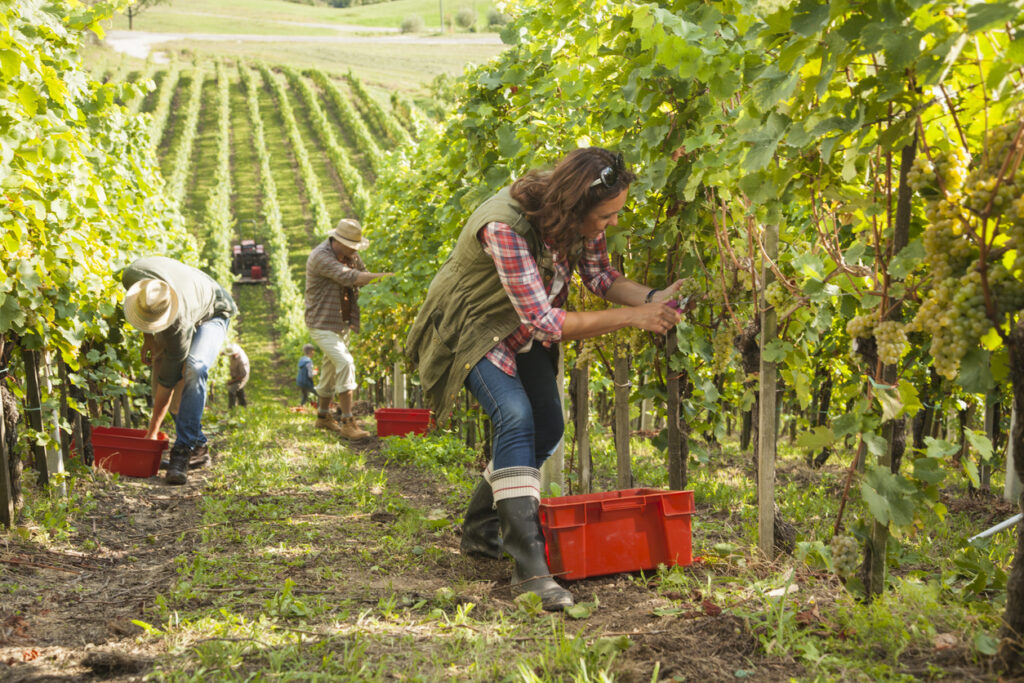Everything You Need to Know About Grape Harvest Tools

Whether you’re a vineyard veteran or new to grape farming, you’ll need to budget for a few harvest tools. Read on to understand the most valuable harvest tools you’ll need, plus other insights and tips about wine harvesting ahead of harvest season.
8 Harvest Tools Needed for Successful Grape Picking
- Bird nettingUsed to protect the fruit zone from birds and other predators while grapes finish their ripening process.
- Side net, 42” x 5,000 feet rolls, black
- Bread clips to secure net, 4,000 per bag
- Over the top net, 14’ x 5,000 feet rolls, black
- Over the top net, 17’ x 2,500 feet in bags, green
- Shade cloth
Used to provide additional shade as needed to ensure even ripening and prevent sunburn on the grape clusters.
– 24” x 3,000 feet rolls, 40% shade, green & black
– 24” x 3,000 feet rolls, 30% shade, white - Thinning shearsHave become the most commonly used tool for removing clusters from the vine.
– Vaca, Zenport, Bahco
– Curved blade or straight blade models - Grape knivesTraditional harvest knife and cutting tool with a hook-shaped blade.
– Serrated or non-serrated
- Sharpening stones, Speedy SharpsUsed to keep grape knives sharp for efficient picking.
- Harvest binsUsed to collect grape clusters down the vineyard rows during manual picking.
– Ergonomic (grey) and traditional lugs (white)
- Lamps and Batteries
Adequate lighting is the key to a successful night harvest, which is why most crews rely on high-powered headlamps to lead the way. - RefractometerSome winemakers utilize their taste buds to determine when the fruits are ready to harvest. But with a refractometer, you can perform fast tests to examine if the sugar concentration in the fruit is suitable for processing.
How Do You Take Care of Your Grape Lugs, Crates, and Harvest Bins?
Grape lugs and harvest bins are critical during harvest, therefore a high priority should be placed on maintaining them. Consider these helpful hints:
1. Temperature
Follow the minimum and maximum temperature standards. Small cracks can form due to frequent use outside specified thermal gradients as well as significant temperature variations.
2. Filling
Keep the mass ratio in mind. Not exceeding the recommended weight also makes the tools convenient to carry.
3. Handling and Stacking
Avoid dropping heavy items on the base of the bins or pushing them over onto rough floors. Patented interlocking corners enable safe ten-high layering. Store the items on hard, flat surfaces away from people. Additionally, be cautious while de-stacking bins stored outside because rain droplets can collect on the top. The post design is also paramount in offering stability and load transfer. Therefore, avoid inter-stacking with other container types.
4. Cleaning
To extend the life of your bins, clean them with high-pressure washers or hot water steam cleaners rather than harsh chemicals.
When are Wine Grapes Harvested?
Do you know that we’re almost getting to the grape harvesting season? Picking occurs between February and April in the Southern Hemisphere and August to November in the Northern Hemisphere. Depending on specific climate conditions, grape types, as well as wine styles, grape picking could happen in any month of the year and anywhere.
How Long Does a Wine Harvest Last?
Harvest time is usually two to three months long. Harvesting days are crucial, and some farmers hold fiestas to commemorate the occasion.
How Are Grapes Harvested?
Grape picking happens in two ways:
1. Manual Picking
The harvest crew uses sharp clippers or knives to cut grapes from the vines and put them in containers arranged along the plant rows. Notably, harvesting grapes by hand can yield superior results. Skilled personnel will cut off bunches and place them in containers with care.
2. Machine Picking
An over-the-row harvester moves through vineyards, shaking fruits off the plants and into enormous reservoirs with fiberglass rods, or rubber. This method is efficient since the grapes go from being on the plant to being crushed and placed in a cooling tank in less than half an hour. On the other hand, manual picking of grapes takes at least four hours.
What Can You Do to Avoid Hazards During Grape Harvest?
Wineries may prefer harvesting at night since it produces superior wine and allows them to regulate the fermenting process better. However, hazards are considerably more widespread.
Harvest workers can guarantee night-harvesting safety by employing the proper safety equipment. Also, the supervisors should walk the field during daytime hours, marking any risks with reflectors and trimming any vegetation or gaps that may obstruct their progress.
How Can A&J Assist?
Having high-quality harvest tools helps you optimize your working conditions and minimize risks in your vineyard. A&J Vineyard Supply offers a wide range of tools and supplies, focusing on vineyard trellis equipment. Feel free to contact us and have a happy harvest season!
